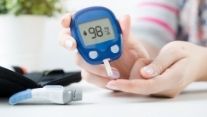Diabetes mellitus (DM) is a chronic illness which is characterized by high blood glucose level. This rise in blood glucose level can be due to two different reasons, based on which DM is divided into two types. These types are Type 1 Diabetes and Type 2 Diabetes.
Type 1 Diabetes, also named insulin-dependent diabetes, is a disorder that is described by the insufficiency of the body to produce insulin, therefore, unable to control the glucose level in blood. Type 2 Diabetes is categorized by high blood glucose levels due to the inability of the body to respond to insulin hormone (which is being produced by pancreatic cells in significant amounts).
Diabetes is a complex metabolic disease, which has now become an epidemic owing to its global prevalence. Currently, more than 400 million individuals are affected by DM, and this number is increasing swiftly all over the Globe. Estimates are that by 2045 this number will grow to 628.6 million around the World. Moreover, diabetes is predicted to turn into the seventh biggest reason for death around the World by 2030.
Persistent hyperglycemia, along with different other metabolic abnormalities, results in severe harm to many organs of the body. This damage eventually leads to lethal secondary complications, most common among which includes micro-vascular and macro-vascular complications, which increases the possibility of cardiovascular diseases by 2 to 4 folds. Therefore, the detection of rising blood glucose level at its early stages can help physicians in saving the lives of millions of individuals.
Other Causes of High Blood Glucose Level
Other than diabetes, the high blood glucose level is associated with different diseases such as; an overactive thyroid, hormonal disorder, pancreatitis, heavy body stress due to any surgery, trauma, or medical illness, specific medication, and even cancer.
Low Blood Glucose Level
The condition of low blood glucose levels is termed hypoglycemia. It is not a common medical condition, yet it is associated with different diseases. Some known diseases are hypopituitarism, Addison’s disease, hypothyroidism, liver diseases, insulinoma, and Kidney Diseases.
Blood Glucose Tests
A blood glucose test determines the amount of it present within a blood sample. As blood glucose test indicates it’s level in the body; therefore, it is the first and most commonly employed method for the detection of diabetes.
For analyzing the blood glucose level, specific instructions and guidelines are given by the American Diabetes Association and the World Health Organization, according to which blood glucose level is measured with the following methods.
Fasting Blood Glucose Test (FBGT)
Fasting blood glucose test (FBGT) is conducted in fasting conditions, where fasting means not eating or drinking anything for at least eight consecutive hours.
There are four different categories of suspected individuals, based on the results of FBGT:
- Normal– if Fasting Blood Glucose is lower than 100 mg/dl.
- At-Risk– if the readings fall between 101 – 108 mg/dl, the individual is suspected to be at the risk of diabetes.
- Pre-Diabetic– if the measurement levels fall between 109 – 125 mg/dl, the condition is known as pre-diabetic. It is a state in which you are at the maximum risk of getting diabetes.
- Diabetic– if the measurements cross the threshold of 125 mg/dl, you are diabetic and should get immediate treatment.
Oral Glucose Tolerance Test (OGTT)
Oral Glucose Tolerance Test tracks the record of the blood glucose level at intervals of 2 hours, and it should be conducted at least three times after taking some drink that’s rich in it or oral ingestion of sugary drinks.
It provides information about the capacity of one’s body to absorb glucose. Measurement of >200mg/dl depicts the presence of diabetes, whereas readings within the range of 140 mg/dl and 199 mg/dl confirm that you are a pre-diabetic person. Measurements of <140 mg/dl shows that you are not diabetic.
Why Regularly Measuring the Blood Glucose Level is Essential?
The most important thing that you can do to properly manage your diabetes (both type 1 and type 2) is the regular measurements of blood glucose levels. It helps you to manage diabetes in the following ways:
- The process supports you to learn about your diabetes status, whether you are at risk, pre-diabetic, or diabetic individual.
- It helps you to evaluate the efficacy of medicines that you are using to improve your blood glucose level. If your blood sugar level doesn’t come back to normal after taking a particular medication, then you must change your medicine.
- It helps you in finalizing the diet plan; for example, if you make a diet plan and still your sugar level is more than the acceptable range; then you need to change your diet plan.
Diabetes-Friendly Diet
The diet plays a crucial role in preventing and managing blood glucose level. Obesity is one of the leading factors for diabetes; therefore, foods promoting obesity should be eliminated. The plant-based whole foods demonstrate excellent anti-obesity and anti-diabetic activity.
Many previous studies have shown that people who eat plant-based diets have controlled body mass index and are at a lower risk of developing diabetes. For example, a on 62 individuals illustrated that people who eat a plant-based diet had a reduction in 7.5% of their body weight, which was highest as compared to all other non-vegan groups.
Similarly, another study showed that the incidence of diabetes was 23% lower in people who consume plant-based diets as compared to the consumers of non-plant based diet. Therefore, a plant-based diet is recommended to control BGL and prevent diseases linked to abnormal glucose levels.
Conclusion
In short, regular monitoring of blood glucose levels helps you to make the right choices about your best diabetes care plan. These decisions not only assist in delaying diabetes mellitus but also help in preventing diabetes-associated secondary complications, including kidney diseases, amputation, blindness, strokes, and heart attack.








































